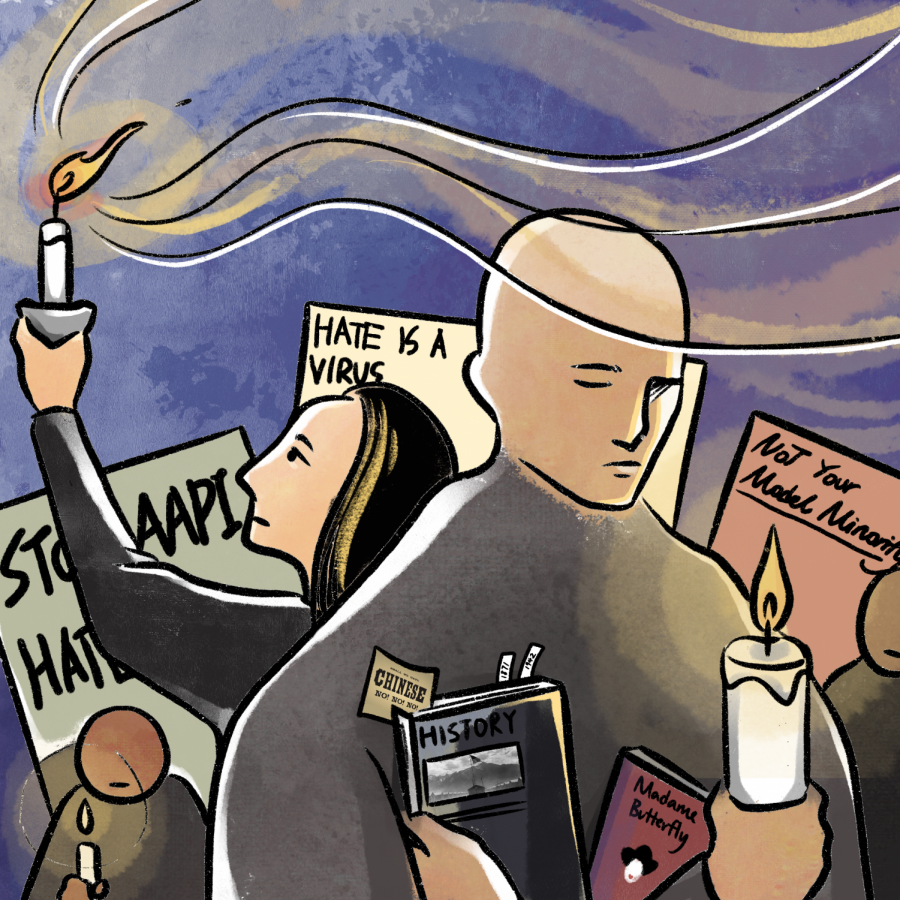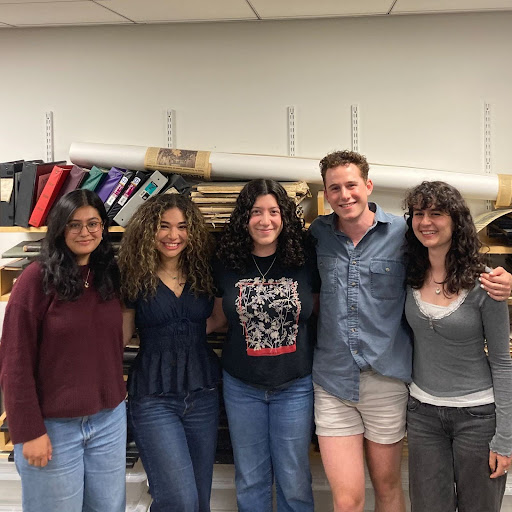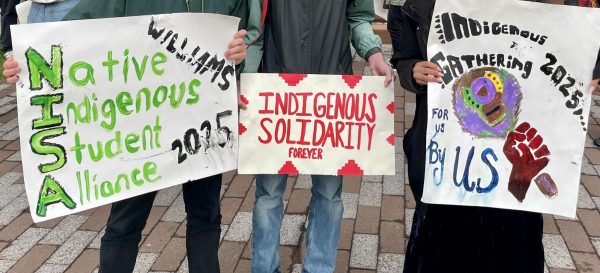‘A larger history of racialized and gendered violence’: Professors, students discuss anti-Asian hate

In 1995, Professor of History Scott Wong flew to China to meet his newly adopted daughter. To complete the adoption process, Wong visited the American embassy in Guangdong, where he was asked two questions about his child: Is your daughter a member of the Chinese Communist Party, and is she a prostitute?
“I say, ‘She’s six months old!’” Wong said. “Why he decided to ask those questions of a 6-month-old infant is beyond me.”
Over 25 years later, the underlying racial and gender implications of the consular officer’s questions about a Chinese female baby still reverberate throughout the United States. Asian Americans have long been subject to racist dehumanization and othering, professors who spoke to the Record say, which expressed itself on March 16, when a 21-year-old white male drove to three spas and massage parlors in Atlanta, Ga., and opened fire. The shooter killed eight people, six of them Asian women. As news feeds across the nation became flooded with headlines, the Asian American community watched as the shooter claimed that race was not a factor in the shootings, and Captain Jay Baker of the Cherokee County Sheriff’s Department said that Long was just having a “really bad day.”
The Asian American community watched, and many of its members refused to accept what they decried as the continued erasure and destruction of the Asian body — in particular, the Asian female body — from American history. “The Atlanta shootings aren’t an isolated incident, but rather indicative of a larger history of racialized and gendered violence in the United States that marks Asian women as disposable, submissive bodies,” Audrey Koh ’21, a member of Asian American Students in Action (AASiA), wrote in an email to the Record.
A history of anti-Asian racism
Though the Atlanta shootings catapulted the issue of anti-Asian violence into the national consciousness, incidents of racialized violence toward Asians and Asian Americans, especially women, are not uncommon in American history. Associate Professor of American Studies Jan Padios recounted various examples throughout the 20th century: attacks on Indians in New Jersey by the Dotbusters in 1987, the murder of a Korean graduate student in a killing spree in the Midwest in 1999, and the lethal beating of a Cambodian American man in South Philadelphia in 1999. “I see Atlanta on a continuum with these,” Padios said.
This continuum stems from the legacy of Western demonization of Asian people that began in Europe, according to Professor of American Studies Dorothy Wang. “In Europe, these racist and Orientalist views of Asians (e.g., as ‘heathen despots’) were based in race science, Christian missionary ideology, and power politics, among other factors,” she wrote in an email to the Record.
As an example of the interaction between these hierarchies, Wang pointed to the Opium Wars of the 1800s between Western powers (primarily Britain) and Qing Dynasty China. “In the nineteenth century, the British dumped opium in China because of a huge trade imbalance caused by their desires for Chinese goods,” Wang said. “Then, they turned around and portrayed the Chinese as weak and dissolute opium addicts… Colonialism and racial capitalism, undergirded by race science, have always worked hand in hand.”
Padios said the spread of European perceptions of Asia to the United States saw the establishment of these racist, misogynist ideas as the foundation of American military action. “In 1898, the United States colonized the Philippines, then came Korean War, then Vietnam, then the Secret Wars in Laos and Cambodia,” she said. “These are all sites where the military committed atrocities.”
As the United States’ military presence in Asian countries expanded, so too did various sexual economies: entire markets for members of the American military to “rest and relax” using Asian women’s bodies. “Part of that war making is sexual assault on women during the course of war, but then also for the sexual pleasures of military men,” Padios said. “Sexual economy emerges, and this is where you get the image of a Southeast Asian woman who is a prostitute that then appears in films.”
Visiting Assistant Professor of American Studies Anthony Kim also traced the hypersexualization of Asian women in America to the media and its denigrating portrayal of their bodies and their relationship to white men. “If you watch television and media, Asian women are seen as menacing dragon ladies or submissive lotus blossoms,” he said. “So, basically, they’re just objects of either revulsion or desire as structured by the white male gaze.”
Wong said the intersection of racist anti-Asian sentiment and misogynist anti-female sentiment has also been expressed in legislation specifically targeting Asian and Asian American women. “The Page Law of 1875 said that Chinese women could not immigrate unless they could prove they were not prostitutes,” Wong explained. “The Cable Act [of 1922] said that if an American citizen, a woman, marries someone who’s ineligible to become a citizen, she would lose her citizenship. And as of 1922, the only people who were ineligible to become citizens were Asian immigrants.”
Anti-Asian violence and fetishization during the pandemic
Grace Fan ’19, who wrote a senior thesis on the interaction of race and gender with hookup culture, highlighted the role of the hypersexualization of Asian women in the Atlanta shootings. The shooter claimed he had a “sexual addiction,” and his “temptation” could only be eliminated through the shootings. “That mentality doesn’t come from nowhere, right?” Fan said. “Living in the U.S. as an Asian woman, you’re experiencing the legacies of these incidents and also the systems that created them in your personal life, and you’re like, ‘Why do men treat me like this? Is there something wrong with me?’”
Though Atlanta has become a symbol of the continued existence of anti-Asian hate and violence in the United States, hate crimes against Asians and the Asian American community have been on the rise since the beginning of the COVID-19 pandemic. In 2020, anti-Asian hate crimes increased by nearly 150 percent while overall hate crimes dropped by 7 percent, and of a reported 3,795 incidents collected by Stop AAPI [Asian American Pacific Islander] Hate, 68 percent of the victims were women.
Kim attributed the upward trend in anti-Asian hate crimes to the onset of the COVID-19 pandemic and rhetoric that conflated the virus with Asian populations. “During COVID-19, the fact that [Donald Trump] continued to call it the ‘kung flu,’ he called it the ‘China virus’ — I mean, words have consequences, right?” he said. “Words have costs and consequences, and those consequences are endured by people’s bodies — actual people’s bodies.”
According to Wang, this association between Chinese Americans and the places they live, such as Chinatowns, with contagion predates the COVID-19 pandemic. “In the nineteenth century, it was common to see racist images of Chinese eating rats and dogs in popular media, advertising cards, and political cartoons (we see that same demonization recycled in the current trope of Chinese and “bat soup”),” Wang said.
Such direct, inflammatory rhetoric provoked latent anti-Asian sentiment within the United States, according to Wong. “It just gives people an excuse to let their other anti-Asian feelings come out,” he said. “It’s hard to determine how many people really blame China for COVID… And, yes, this would have happened eventually, whether it be a massage parlor, or whether it be a restaurant or [an Asian] grocery store.”
Consequences of the model minority myth
While people of Asian descent have always confronted racism in the United States, Padios said that much of what they face is obscured by the model minority myth. “The model minority myth emerged after World War II as a way for proponents of racial liberalism to try to prove that racism was not a problem in the United States, and the way that they tried to prove this was by demonstrating that Asian immigrants and Asian Americans in the United States may have experienced racism, like Japanese incarceration or anti-Chinese exclusion, but had overcome it,” Padios explained.
Fan pointed out how the model minority myth only serves to further divide and suppress members within the Asian American community itself. “All of a sudden, we don’t have to pay attention to the different oppressions that exist,” she said. “The life of a wealthy educated East Asian person is very different from a low-income migrant worker who’s a refugee from Southeast Asia. The term ‘Asian American’ in itself kind of smooths over all of the different histories.”
Wang argued that in the end, no matter what they do, even those who are able to achieve proximity to whiteness within the model minority structure find that they are unable to fully integrate into white society. “Asian Americans are sometimes described as ‘honorary whites,’ but they do not have white privilege and are not treated as white people,” Wang said.
One consequence of the pressure to conform to whiteness in America, Kim said, is the anglicization of Asian names. For Kim, the publication of the six Asian female victims’ non-anglicized names after Atlanta was particularly poignant. “What was personally devastating was that these women’s names were so familiar to me,” he said. “They were names for people who inhabit the neighborhoods and communities and workplaces that I’ve been a part of or passed through. It really hit home.”
“It just really struck me because I think of all the ways that names have a kind of importance in American society, the ways that names are supposed to conform to these standards of English and standards of whiteness,” he added.
And while the circulation of the women’s non-Asian names shed a light on their lives, Wong realized another level of erasure that came with it. “There won’t even be a sort of ‘Say Their Names’ movement because so many Americans can’t say their names,” he said.
Even while Asian Americans are consistently used as a prop to uphold white supremacy, Wang said, they are perpetually seen as foreigners. “I have had a white Williams student ask me if English is my native language, even though I have a totally American accent and have a Ph.D. in English literature,” she said. “I have had a distinguished and highly educated faculty member ask me why I am teaching Asian American literature in an American studies program. Faculty not infrequently think that I teach in the Asian studies program.”
Professors, students call for Asian American studies
For many Asian American students and faculty at the College, the invisibility of their experience is most apparent in the lack of an Asian American studies program. “Williams students have fought for an Asian American [studies] program for over 30 years,” Wang said. “If there is an Africana department and a Latino/a studies program, then there must be an Asian American studies program.”
Advocates for the inclusion of Asian American studies in the College’s curriculum argued for the importance of Asian American students knowing their own history within the country and how it influences their present experiences. “Asian American studies is where students would be given the tools to think through such events, to understand their historical antecedents, to unpack multiple oppressions,” Padios said.
Fan said she perceived the College’s lack of commitment to an Asian American studies program as a reinforcement of the ignorance that has characterized Asian Americans’ experiences in the United States. In response to the College’s statement on supporting the Asian American community, she wrote in a Facebook post, “When the Williams admin denounces anti-Asian violence, let us not forget that ignorance is violence, negligence is violence, and, at the very least, Williams could grant Asian American students a space to learn/dream/process as we also worry that our loved ones might be the next victims of white supremacist, xenophobic violence.”
Koh expressed similar frustrations with the College’s response in the face of how it “has continually invalidated and belittled students asking for an Asian American studies program.”
“So I ask the College: Will you commit to institutionalizing Asian American studies so Asian and Asian American students have a system of support and a material community space, and students can learn about Asian American histories and understand Asian American experiences?” Koh said.
In response to criticism about the lack of an Asian American studies program, President Maud S. Mandel reaffirmed the College’s commitment to the planning framework laid out in the Curricular Planning Committee report in spring 2019. “The first open [Asian American studies] position was filled in American studies 2019-20, the second position will be posted in the upcoming academic year,” she wrote in an email to the Record. “Once that position is filled, colleagues on campus with an expertise in Asian American studies will create the program which will then be evaluated by the faculty (as is the case with all new programs). I am fully in support of this initiative.”
As the nation moves forward, members of the Asian American community hope for change even as they mourn the victims of the Atlanta shootings. “I would hope that Atlanta would make some people who aren’t aware that there is anti-Asian sentiment … start looking out for it,” Wong said. “Hopefully, it will bring Asian American students closer together, but at the same time, I really hope that you don’t all walk around constantly afraid.”
Wang expressed a need for the College to take more concrete action than just sharing rhetoric about diversity. “[The Office of Institutional Diversity and Equity (OIDEI)] and the Davis Center must give equal acknowledgment and voice to Asian American students and issues,” she wrote. “There needs to be much greater hiring of Asian American deans, staff (e.g., in the Davis Center, the Dean’s Office), and faculty… Deans and mental health staff need to understand the rampant sexualizing of Asian American women and how those stereotypes greatly increase the possibility of sexual assaults.”
She also noted the necessity for attention to “the mental health crises affecting Asian American students, especially women and queer and trans men.”
In an email to the Record, Interim Vice President for the OIDEI Ngonidzashe Munemo spoke on the College’s efforts to recruit and retain a diverse staff trained to support students of minority identities. “The college is also committed to ensuring that staff are equipped to work effectively with students in ways that recognize their specific and intersectional identities and experiences,” he wrote. “For example, this January the entire IWS [Integrated Wellness Services] team completed a specialized training on supporting those who have experienced racial trauma.”
Munemo encouraged students who do not feel recognized by the College to reach out to resources like the OIDEI or the Davis Center. “[We] know that there is more to be done to ensure that everyone feels fully included everywhere at the college,” he wrote. “We encourage students to share any concerns they have with a member of the team so they can be addressed.”
Fan expressed her hopes that Asian American students make their voices heard. “If there’s anger in the Asian American community, use it, channel it, do something about it,” she said. “Take ownership of your education that you are paying for… I want the Williams AAPI community to get riled up.”
Lindsay Wang ’24 is an English and statistics major from Pleasanton, Calif. She is a senior writer, and she previously served as the editor-in-chief,...
Justin Zen ’24 is a prospective economics major from New York City, N.Y. He is the executive editor for editorials and co-director of staff. He previously...







